Kroemer Library Mosaic in Honor of Rev. Dr. Dean O. Wenthe
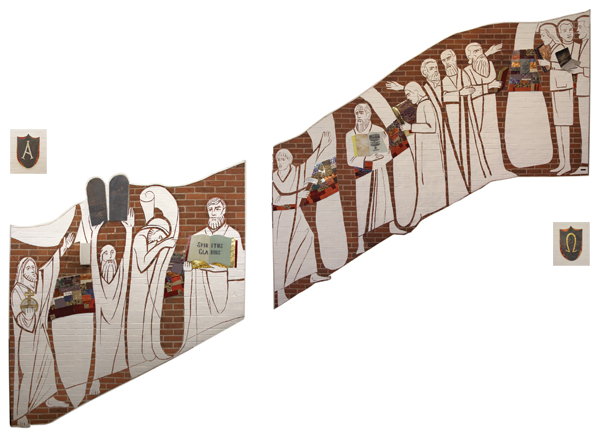
Everlasting Son of the Father
The following image and explanation of this new artwork in Walther Library is taken from The Restoration of Creation in Christ: Essays in Honor of Dean O. Wenthe (Concordia Publishing House, 2014).
During Dean O. Wenthe’s tenure as president of Concordia Theological Seminary, the three-decade dream of expanding the library on the Saarinen-designed campus became a reality. Careful and painstaking work with architects and contractors who were sensitive to the seminary’s desire to maintain the integrity of the original design of the campus resulted in an expansion of the existing library into a world-class facility that will serve the seminary for years to come.
The architectural beauty of the CTS campus is matched by an artistic plan unified under the theme of the ancient church’s hymn of praise, the Te Deum. Wood, metal, fabric, and stone are joined in various works of art around the campus, inviting all who step on the campus to rejoice in the beauty of God’s creation as it points to his saving work in Christ.
Among those original works of art is a combination of bas-relief and mosaic on the south wall of the Dining Hall. By carving into the white-washed rectangular bricks, Saint Louis artist William Severson was able to create a captivating image of the saints gathered together, singing their praises to God. A pattern of colored plastic, enameled copper, and stained glass chips in the center of the image takes the shape of a loaf of bread.
In the final design of the library expansion, two brick towers of white-washed brick were erected next to the grand staircase that connects the first of two “lantern” buildings with the main collection in the lower level. These towers serve as the canvas for a new work of art created by Fort Wayne artist William Lupkin.
In form, this new work of art was inspired by the carved relief in the Dining Hall. In theme, this work builds upon Christ, “the everlasting Son of the Father,” represented in the existing library mosaic by the incarnate Christ holding the Bible with the Greek letters Alpha and Omega inscribed upon its open pages. The new work begins at the bottom of the staircase with Christ and continues with images depicting the foundation of the law and the prophets, as well as the apostolic witness, on the first column (above left). The second column (above right) begins with Luther, nailing the 95 theses, and Chemnitz, holding a Book of Concord. This Biblical and confessional identity is handed on to our seminary founders, Loehe, Craemer, Sihler, and Wyneken, who in turn hand it on to our students, diaconal, international, and pastoral. In its wholeness, the work captures the transmission of the Word through the ages, providing a fitting image of the role of a theological library and a seminary faculty.
-Robert V. Roethemeyer
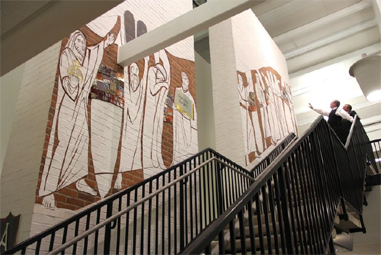
View from Lower Level
This view from the lower level of the library expansion shows the grand sweep of the staircase next to the two brick towers on which the bas relief sculpture was executed. (Note the plaque with the alpha in the lower left corner. The corresponding omega is located around the corner at the very top of the staircase.)
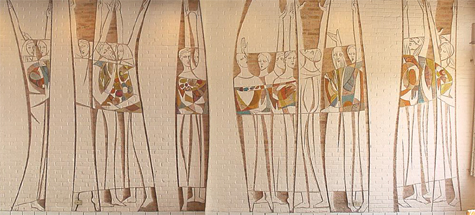
Inspiration
The inspiration for this new artwork is found in a similar piece that was executed in the dining hall over 50 years ago by William Severson of St. Louis. The canvas, so to speak, is a wall of whitewashed rectangular bricks. By carving into the brick, the whitewash is brushed away to reveal the natural color of the brick and the outline of the figures. Color is selectively added to accentuate, in this case, a loaf of bread.
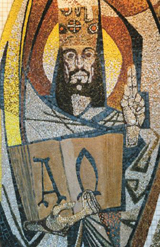
Library Entrance
This figure of Christ adorns the entrance to the Historic Walther Library building. Note the similarities in the face of Christ that found in the interior sculpture.
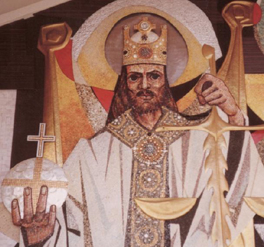
Wyneken Hall Entrance
Note the similarities in the face of Christ from this historic mosaic to the Kroemer Library sculpture.
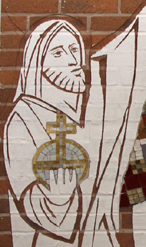
Face of Christ from New Sculpture
This piece was intentionally crafted to be consistent with the historic pieces from throughout the campus.
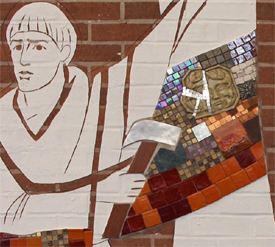
Martin Luther
This image depicts Luther posting the 95 Theses. The artist reports that the broken image utilized here was intended for another project until it cracked during the firing process. In this setting, the image suggests the breaking of the medieval church’s silencing of the Gospel.
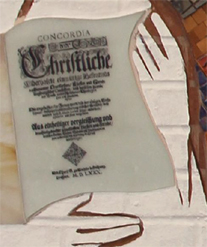
Martin Chemnitz
The figure of Chemnitz holds the Book of Concord. Here the artist has painted the entire cover of the Dresden 1580 edition as it appears in a first edition volume that is owned by the Seminary. Upon completion of the renovation of the existing library, which will include a new state-of-the-art rare book room, this volume will find its permanent home in Walther Library.
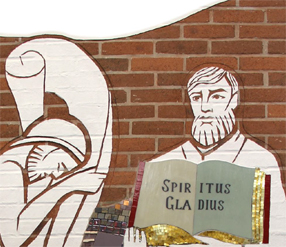
The Sword of the Spirit
Stand therefore, having fastened on the belt of truth, and having put on the breastplate of righteousness, and, as shoes for your feet, having put on the readiness given by the gospel of peace. In all circumstances take up the shield of faith, with which you can extinguish all the flaming darts of the evil one; and take the helmet of salvation, and the sword of the Spirit, which is the word of God, praying at all times in the Spirit, with all prayer and supplication. (Ephesians 6:14-18a ESV)

Close Up
These close-ups show the detail of the carving. Note that in addition to removing the whitewash, the carver also made deeper cuts into the red brick to outline some of the main features.

Material Variety
Stone, glass and other materials are used throughout the mosaic. Close-ups of some of the mosaics reveal the variety of materials that the artist employed to introduce both color and texture.
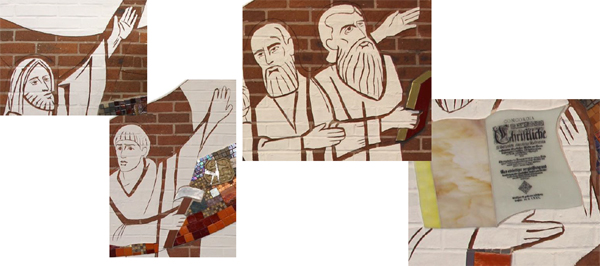
Yesterday, Today, Forever
Supporting the theme of the sharing of the Word through the ages is the artist’s expressive use of the hands of the various characters in history to depict that communication.




